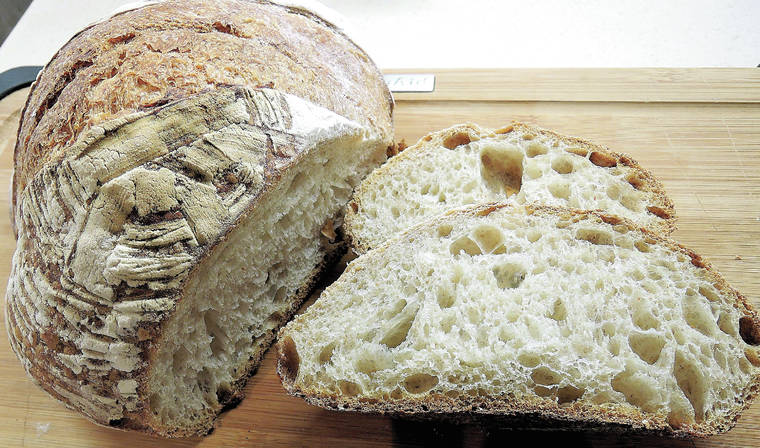No yeast? Here’s the easy way to start a sourdough starter from a baking expert

Anyone with a passing interest in bread baking should follow Andrew Janjigian, a self-described “breadhead” online, and subscribe to his newsletter; sign up at wordloaf.substack.com. And, of course, read him in Cook’s Illustrated.

Once it has hit its bread-making stride, sourdough starter can be stored in the refrigerator, untouched, for a few months. (Dreamstime/TNS)
Would-be bread bakers, you’re not mistaken. The spike in demand for flour and yeast that you’re witnessing in supermarkets is real.
Would-be bread bakers, you’re not mistaken. The spike in demand for flour and yeast that you’re witnessing in supermarkets is real.
“At the beginning of the COVID-19 crisis, people worried about staying at home, and so they stocked up, a lot,” said Mike Oase, chief operating officer of Kowalski’s Markets, which has 11 Twin Cities locations. “People bought everything in sight. It was bigger than a Christmas week.”
Oase said that flour supply lines are returning to normal. “And yeast will be back in stock in the next few weeks,” he said.
The phenomenon of empty baking-aisle shelves did not go unnoticed at America’s Test Kitchen, the Boston-based publisher of Cook’s Illustrated and Cook’s Country magazines.
The difficulty of finding yeast at the supermarket came up during an online staff meeting. That’s when senior editor Andrew Janjigian — known to his fellow staffers as “the Bread Guy” and/or “the Bread Whisperer” — offered a solution.
“It’s the perfect opportunity to start a sourdough starter,” he said.
He’d tackled the subject in Cook’s Illustrated about four years ago, but that formula called for two pounds of flour.
“Given how little flour there is out there right now, I decided to try it on a much smaller scale, and see how it works,” it said.
Turns out, it works just fine. Janjigian began to document the process on his Instagram account (@wordloaf), and the experiment — which he dubbed #quarantiny-starter — went viral. “Or, as I like to say, ‘fungal,’?” he said with a laugh, mentioning that yeast is a fungus.
To date, he’s playing a kind of sourdough Pied Piper to about 600 fellow bakers, following along from as far away as Australia and Malaysia. “The list of names that people are calling their starters is really good,” he said with a laugh. They include Clint Yeastwood, Courtney Loave, Carrie Breadshaw, Bread Astaire, Holly Doughlightly and Quentin Quarantino, and no, Janjigian hasn’t christened his.
Because Janjigian has so many bakers following along in real time, he has fielded a lot of questions. Here he is on …
Flour: “Ideally, you want to start with a mix of white with whole wheat or rye, because that extra nutrition will make things happen faster,” he said. “But I’ve done it using only all-purpose. It has to be wheat flour and unbleached. The organisms that you get in sourdough don’t come from the air or from your hands. It’s from the flour itself.”
Temperature: “The ideal temperature for sourdough is 78 degrees; that’s when both bacteria and yeast are happiest,” he said.
Container: “It doesn’t really matter, as long as it keeps the starter from drying out,” he said. “Glass, plastic, Mason jars, deli containers. It’s nice to have a clear, straight-sided container, so you can see when it’s doubling and tripling.”
“Feeding” vs. “refreshing” the starter: “Think about pets,” he said. “You put food in a bowl, and they eat it. That’s feeding. But here, you’re moving your culture through fresh food and water each time. Rather than continually adding water and flour to the same container, it’s the idea of taking a portion of the old culture and using it to inoculate a fresh container — you want the acids that they produce to be relatively dilute — so they can propagate in that new environment.”
The schedule: “Those first two to three days are to get it alive,” he said. “After that, you start refreshing it daily. After about seven days, it should be going enough so that you can do it twice a day.”
Storage: Once it has hit its bread-making stride, the starter can be stored in the refrigerator, untouched, for a few months. “But remember, the longer it goes without being refreshed, the longer it takes to get back to its full vigor,” he said.
Anyone with a passing interest in bread baking should follow this self-described “breadhead” online, and subscribe to his newsletter; sign up at wordloaf.substack.com. And, of course, read him in Cook’s Illustrated.
“The first thing I learned to cook was pizza, and I became obsessed with it,” said Janjigian. “But I got the bread bug right after the no-knead recipes came out in about 2006. That’s when I realized how good homemade bread is, and what I’d been missing. That’s when I wanted to master it.”
The basic formula
Creating this sourdough starter is a simple process: In a small container, stir about 1 heaping tablespoon flour with 2 to 3 teaspoons lukewarm water (for exact measurements, it’s 10 grams flour and 10 to 15 grams water). Tightly cover, set aside in a warmish spot and wait three days.
After that, it’s “refresh” mode. Follow the same formula — mix together 1 heaping tablespoon flour with 2 to 3 teaspoons lukewarm water — but add another step: Stir in 1 teaspoon (5 grams) of the ever-developing starter (and don’t discard the rest; see story for other uses). Cover, and then repeat, daily, for about a week.
After that, double down on your efforts and follow the procedure twice a day, in the morning and the evening. By the end of another week or so, you’ll have a starter strong enough to bake bread.
Simple No-Knead #Quarantinystarter Sourdough Bread
Makes 1 loaf.
Note: This dough must be prepared in advance. Levain is the building block for leavened bread. From Andrew Janjigian of Cook’s Illustrated magazine and America’s Test Kitchen and adapted from King Arthur Flour. If your starter is already on a large enough scale to yield 30 grams — plus extra for refreshing, don’t forget that! — then you can skip the levain hydration step and mix it into the dough directly. If your kitchen is very cold, you can increase the amount of your levain to 50 grams. In the heat of summer, you can get away with as little as 5 grams.”
For 100% hydration levain (see Note):
— 40 g (1/3 c.) bread flour or high-protein all-purpose flour (see Note)
— 40 g (3 tbsp.) lukewarm (75 degrees) water
— 20 g (4 tsp.) sourdough starter (see the formula below)
For dough:
— 360 g (1 2/3 c.) lukewarm water (75 degrees), divided
— 30 g (1 tbsp.) levain (from above)
— 500 g (3 1/4 c.) bread flour or high-protein all-purpose flour (see Note), plus extra for shaping dough
— 10 g (2 tsp.) salt
Directions
To prepare levain: In a small container, combine bread flour, lukewarm water and sourdough starter. Stir until uniform, then cover tightly and let proof at room temperature until between double and triple in volume, about 6 to 12 hours.
To prepare dough, step 1: Place 10 grams (2 teaspoons) water in a small bowl and set aside. In a medium bowl, whisk together remaining 350 grams water (1 2/3 cup water minus 2 teaspoons) with levain until levain is mostly broken up. Add flour and stir with your hands or a wooden spoon until no dry flour remains. Cover bowl and let sit at room temperature for 30 minutes.
Step 2: Sprinkle salt over top of dough, then sprinkle remaining 10 grams (2 teaspoons) water over dough. Working in the bowl, knead dough gently by hand until salt is fully incorporated and dough is uniform in texture (it will remain shaggy). Cover bowl and let sit at room temperature for 30 minutes.
Step 3: Using wet hands, reach under dough, pull it up and fold it over itself, turning a quarter-turn after each fold and folding 8 times, until dough is tight and uniform.
Step 4: Cover bowl tightly and let dough sit at a cool room temperature (68 to 75 degrees) until dough is puffy, jiggly and bubbly, about 12 to 16 hours. (You can generally move to Step 5 anytime within this window, as long as the dough looks right and as long as ambient temperatures aren’t much higher than 75 degrees.)
Step 5: Flour the top of the dough and a clean work surface liberally and evenly. Reach under the dough from the bottom and transfer it to the prepared counter. Pat the dough gently to form a 7-inch disc. Fold the dough’s edges over the center, turning the dough a quarter-turn at a time, to form a round ball. Leave dough on the counter and cover with an upside-down bowl or loosely with plastic wrap and let the dough sit at room temperature for 30 minutes.
Step 6: Line a proofing basket or a colander with a large linen or cotton dish towel and dust liberally with flour. Flour the top of dough ball and the working surface around it. Using a bench knife, carefully unstick the dough from the work surface. Repeat patting and folding as in Step 5 to form the dough into a tight round. Pinch the seam tightly to seal and transfer the dough to the floured towel, seam-side up. Flour the top surface of the dough and fold the towel’s edges over the dough to cover. Place colander in a large plastic bag and cover loosely but completely.
Step 7: Let dough sit at room temperature for 1 hour, then transfer to refrigerator for 8 to 24 hours, depending upon what is more convenient with your schedule. (Or proof at room temperature until the dough has about doubled in size and does not readily spring back when poked with your finger, about 2 to 4 hours. But note that retarding the dough in the refrigerator for 8 to 24 hours will result in better oven spring, easier and better scoring and less worry about when it’s ready to be baked.)
Step 8: 30 minutes before baking, place a large covered cast-iron Dutch oven on the middle rack of the oven and preheat oven to 500 degrees.
Step 9: Fold back edges of towel and dust top of loaf liberally with flour. Lay a 12- by 12-inch piece of parchment paper on a clean work surface. Gently invert loaf onto the center of the parchment paper and remove the towel. Using a sharp knife or a razor blade, make a single 1/4-inch deep slash from edge to edge across the center of the dough.
Step 10: Carefully remove the Dutch oven from the oven and remove the lid. Holding the edges of the parchment paper in both hands, carefully and gently place the dough in the Dutch oven. Cover the Dutch oven, return it to the oven and reduce the oven temperature to 450 degrees.
Step 11: Bake for 20 minutes. Carefully remove the lid and continue to bake until loaf is golden brown, 15 to 20 additional minutes. Carefully remove Dutch oven from the oven. Carefully remove the loaf from the Dutch oven. Return the loaf to the bare oven rack and continue to bake until deep golden brown, 5 to 10 additional minutes. Remove loaf from oven, transfer to a wire rack and allow to cool for at least 2 hours before serving.


